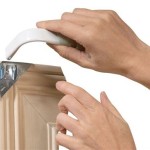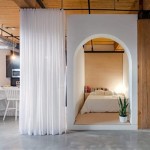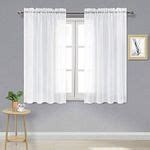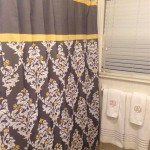Corner Brackets: A Detailed Look at Curtain Rod Support for Unique Window Configurations
Curtain rods are essential components for hanging curtains, providing both functional support and aesthetic appeal to window treatments. While straight curtain rods are suitable for standard windows, corner windows or bay windows require specialized hardware to ensure proper installation and a seamless appearance. Corner brackets are specifically designed to address this need, enabling users to create continuous curtain rod systems that navigate corners and angles effectively. This article will explore the different types of corner brackets available, their installation processes, factors to consider when choosing the right bracket, and the overall benefits they offer for unique window configurations.
Understanding the Functionality of Corner Brackets
The primary function of a corner bracket is to connect two sections of a curtain rod at a corner, allowing the rod to turn a 90-degree angle or another specified angle dictated by the window design. This connection provides structural support, preventing the rod from sagging or becoming unstable at the joining point. Without a corner bracket, attempts to bend a straight rod could result in damage to the rod or an unsightly, structurally unsound installation. Corner brackets are designed to maintain the curtain's smooth traversal along the rod, ensuring ease of use and a consistent visual aesthetic. These brackets are typically crafted from durable materials such as steel, aluminum, or heavy-duty plastics to withstand the weight of the curtains and the stresses associated with daily use.
A well-designed corner bracket not only provides structural integrity but also contributes to the overall aesthetic of the window treatment. Many corner brackets are available in a variety of finishes to match the curtain rod and other hardware, creating a cohesive and visually appealing installation. Some brackets are designed to be discreet, minimizing their visible presence, while others are more decorative, adding an extra layer of elegance to the window treatment. The choice of corner bracket design depends on individual preferences and the overall style of the room.
Beyond simply connecting two rod sections, some corner brackets incorporate additional features. Certain models may offer adjustable angles, allowing for greater flexibility in adapting to non-standard corner angles. Others may include integrated support arms that extend to the wall, providing extra stability, particularly for heavier curtains. The specific features and capabilities of a corner bracket should be carefully considered based on the specific requirements of the installation.
Types of Corner Brackets and Their Applications
Corner brackets are available in a variety of designs, each tailored to specific curtain rod styles and installation requirements. Understanding the different types of brackets is crucial for selecting the most suitable option for a particular window configuration. Some common types include:
Fixed Angle Corner Brackets: These brackets are designed for 90-degree corners and offer a simple and robust connection. They are typically constructed from metal and provide a secure and stable joint between the two rod sections. Fixed angle brackets are ideal for standard corner windows where the angle is precisely 90 degrees.
Adjustable Angle Corner Brackets: For corners that are not exactly 90 degrees, adjustable angle brackets offer the flexibility to accommodate various angles. These brackets typically feature a pivoting mechanism that allows the angle to be adjusted within a specified range. Adjustable brackets are particularly useful for bay windows or other window configurations with non-standard angles.
Elbow Connector Brackets: These brackets are designed to create a smooth curve in the curtain rod rather than a sharp angle. They are often used for creating a flowing drapery effect around a bay window. Elbow connector brackets provide a more subtle transition between rod sections compared to fixed or adjustable angle brackets.
Ceiling Mount Corner Brackets: In some cases, it may be necessary to mount the curtain rod from the ceiling rather than the wall. Ceiling mount corner brackets are specifically designed for this purpose, providing a secure and stable connection for rods suspended from the ceiling. These brackets are often used when wall space is limited or when a particular aesthetic effect is desired.
Decorative Corner Brackets: As mentioned earlier, some corner brackets are designed with decorative elements to enhance the overall appearance of the window treatment. These brackets may feature intricate designs, ornate finishes, or other embellishments that add a touch of elegance to the installation. Decorative brackets are suitable for situations where the bracket is intended to be a visible part of the window treatment.
When selecting a corner bracket, it is essential to consider the weight capacity of the bracket and ensure that it is sufficient to support the weight of the curtains. It is also important to choose a bracket that is compatible with the diameter and style of the curtain rod being used.
Installation Considerations and Best Practices
Proper installation of corner brackets is crucial for ensuring the stability and functionality of the curtain rod system. The installation process typically involves several steps, including measuring, marking, drilling, and securing the bracket to the wall or ceiling. Adhering to best practices during installation can help to avoid common problems and ensure a professional-looking result.
Accurate Measurement: Before beginning the installation process, it is essential to accurately measure the distance between the corner and the desired location of the curtain rod. This measurement will determine the placement of the corner bracket. Use a level to ensure that the bracket is installed horizontally. Inaccurate measurements can lead to uneven curtain hanging and an unstable rod system.
Proper Marking: Once the measurements have been taken, use a pencil or marker to clearly mark the location of the bracket on the wall or ceiling. Use a stud finder to locate wall studs and, if possible, secure the bracket to a stud for maximum stability. If a stud is not available, use appropriate wall anchors to provide adequate support. Incorrect marking can result in misaligned brackets and a compromised installation.
Drilling Pilot Holes: Before attaching the bracket to the wall or ceiling, drill pilot holes at the marked locations. The size of the pilot holes should be slightly smaller than the screws being used to secure the bracket. Drilling pilot holes helps to prevent the wood from splitting and makes it easier to drive the screws straight. Skipping this step can lead to damaged walls and a less secure installation.
Secure Attachment: Use appropriate screws to securely attach the bracket to the wall or ceiling. Ensure that the screws are long enough to penetrate the wall or ceiling material and provide adequate holding power. Over-tightening the screws can strip the threads or damage the bracket. Select screws that are appropriate for the wall material (e.g., drywall screws for drywall, wood screws for wood studs). Using the wrong type or size of screw can lead to a weak or unstable installation.
Testing Stability: After the bracket has been installed, test its stability by applying gentle pressure to the bracket. If the bracket feels loose or wobbly, re-tighten the screws or adjust the anchors as needed. Ensure that the bracket is securely attached before installing the curtain rod and curtains. Neglecting this step can result in the bracket failing under the weight of the curtains.
Using Shims: In some cases, the wall or ceiling may be uneven, causing the bracket to sit at an angle. Shims can be used to level the bracket and ensure that it is properly aligned. Shims are thin pieces of material, such as wood or plastic, that can be inserted between the bracket and the wall or ceiling to compensate for uneven surfaces. Failing to address uneven surfaces can lead to a crooked curtain rod and an unprofessional appearance.
Consulting Instructions: Always refer to the manufacturer's instructions for specific installation guidelines and recommendations. Different types of corner brackets may have different installation requirements. Following the manufacturer's instructions can help to avoid errors and ensure a successful installation. Ignoring the instructions can lead to improper installation and potential damage to the bracket or surrounding surfaces.
Factors to Consider When Choosing Corner Brackets
Selecting the right corner bracket for a particular application requires careful consideration of several factors. By evaluating these factors, users can ensure that they choose a bracket that provides adequate support, complements the aesthetics of the window treatment, and meets the specific requirements of the installation.
Curtain Weight: The weight of the curtains is a primary factor to consider when choosing a corner bracket. Heavier curtains will require a more robust bracket with a higher weight capacity. Ensure that the chosen bracket is capable of supporting the weight of the curtains without sagging or failing. Overloading a bracket can lead to instability and potential damage.
Rod Diameter: The diameter of the curtain rod must be compatible with the opening of the corner bracket. Choose a bracket that is specifically designed to accommodate the diameter of the rod being used. Using an incompatible bracket can result in a loose or unstable connection. Smaller diameter rods may require adapters for proper fit.
Corner Angle: The angle of the corner is another critical factor to consider. For standard 90-degree corners, a fixed angle bracket is typically sufficient. However, for corners with non-standard angles, an adjustable angle bracket is necessary. Measure the corner angle accurately to ensure that the chosen bracket is suitable for the application. Using incorrect angle brackets can lead to gaps or strain on the curtain rod section.
Mounting Surface: The type of mounting surface (e.g., drywall, wood, concrete) will influence the choice of corner bracket and the type of fasteners required. Choose a bracket that is designed to be mounted on the specific type of surface. Use appropriate anchors and screws to ensure a secure and stable connection. Improper mounting can lead to a weakening of the bracket over time.
Aesthetic Considerations: The aesthetics of the corner bracket should complement the overall style of the window treatment and the room. Choose a bracket with a finish and design that matches the curtain rod and other hardware. Consider whether a discreet or decorative bracket is more appropriate for the application. The color and style of the corner bracket can either blend in or create an accent.
Material Durability: The durability of the corner bracket is an important factor to consider, especially for long-term use. Choose a bracket made from a durable material, such as steel or aluminum, that can withstand the weight of the curtains and the stresses associated with daily use. Avoid brackets made from flimsy materials that may bend or break over time. Powder-coated metals can help prevent rusting over the life span of the corner bracket.
Installation Complexity: The complexity of the installation process should also be considered. Some corner brackets are easier to install than others. If you are not comfortable with DIY projects, it may be best to choose a simpler bracket or hire a professional installer. The location of the windows may influence the ease of installation.
By carefully considering these factors, users can select the most appropriate corner brackets for their specific needs, ensuring a stable, functional, and aesthetically pleasing window treatment.

Corner Bracket Ona Drapery Hardware

1 Metal Elbow Corner Bracket Antique Brass Matte Ships Separately

Double Rod Corner Bracket Wood Pole Or Iron 1 Each Drapery Brackets Curtain Heavy Duty Etsy

Corner Bracket Only For Single Rod Iron Or Wood Pole 1 Ea Drapery Brackets Curtain Heavy Duty Etsy

Wall Mount Corner Socket Color Brushed Nickel

Corner Bracket Adjustable 3 To 4 1 2 Projection

Standard Corner Curtain Rod Connector

Drapery Rod Corner Connector For Classic Round Rods Bay Windows

Rejuvenation Drapery Pivot Corner Bracket 1 4 Aged Brass

90 Degree Curved Corner Elbow With Attached Pole Connectors Color Matte Black








